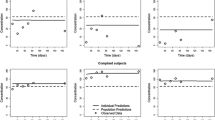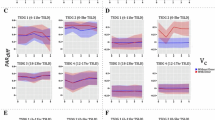Abstract
Purpose. In population pharmacokinetic studies, the dosing history is sometimes recorded in more than one way. The purpose of this study was to develop and evaluate a procedure for discriminating between rival dosing histories, i.e., for each individual in a data set, identify the dosing history that is the most plausible.
Methods. The procedure consists of four steps. In the first step we identify individuals whose dosing histories produce predictions that are consistent. In the second step these individuals are used to build a population pharmacokinetic model which is used, in step three, to select the dosing history for the individuals not identified in step one. In step four the population model is refined using the best available dosing histories for all individuals. The proposed procedure was evaluated using both simulations and a real data set, in which two dosing histories, based on patient diaries and electronic monitoring devices (MEMS) were available.
Results. In the real data set, estimated variabilities were almost always lower when the selected dosing histories were used compared to when no selection procedure was used. The diary dosing histories were selected more often than the MEMS dosing histories. In the simulations, the parameter estimates obtained using the selection procedure were closer to the true parameter values compared to when only one of the dosing histories was used.
Conclusions. The proposed procedure appears to be robust and should be beneficial in at least two respects: improved parameter estimation of population pharmacokinetic and PK/PD models and objective information by which dosage recording methodologies can be compared and patient dose recording behavior can be assessed.
Similar content being viewed by others
REFERENCES
L. Aarons. Eur. J. Metab. Pharmacokin. 18:97–100, 1993.
E. J. Antal, T. H. Grasela Jr, and R. B. Smith. J. Pharmacokin. Biopharm. 19:37s–46s, 1991.
J. Urquhart. Clin. Pharmacokin. 27:202–215, 1994.
J. K. Aronsson and M. Hardman. Brit. Med. J. 305:1009–1011, 1992.
D. Matsui, C. Hermann, J. Klein, M. Berkovitch, N. Olivieri, and G. Koren. J. Clin. Pharmacol. 34:944–949, 1994.
N. F. Olivieri, D. Matsui, C. Hermann, and G. Koren. Arch. Dis. Child. 66:1399–1402, 1991.
L. B. Sheiner, B. Rosenberg, and V. V. Marathe. J. Pharmacokin. Biopharm. 5:445–479, 1977.
L. B. Sheiner and S. L. Beal. J. Pharm. Sci. 71:1344–1348, 1982.
A. J. Boeckmann, L. B. Sheiner, and S. L. Beal. NONMEM users guides. NONMEM project group, University of California, San Francisco, CA, 1992.
D. W. Cockroft and M. H. Gault. Nephron 16:31–41, 1976.
M. O. Karlsson and L. B. Sheiner. J. Pharmacokin. Biopharm. 21:735–750, 1993.
M. O. Karlsson, S. L. Beal, and L. B. Sheiner. J. Pharmacokin. Biopharm. 23:651–672, 1995.
E. I. Ette and T. M. Ludden. Pharm. Res. 12:1845–1855, 1995.
Author information
Authors and Affiliations
Corresponding author
Rights and permissions
About this article
Cite this article
Jonsson, E.N., Wade, J.R., Almqvist, G. et al. Discrimination Between Rival Dosing Histories. Pharm Res 14, 984–991 (1997). https://doi.org/10.1023/A:1012184808192
Issue Date:
DOI: https://doi.org/10.1023/A:1012184808192




